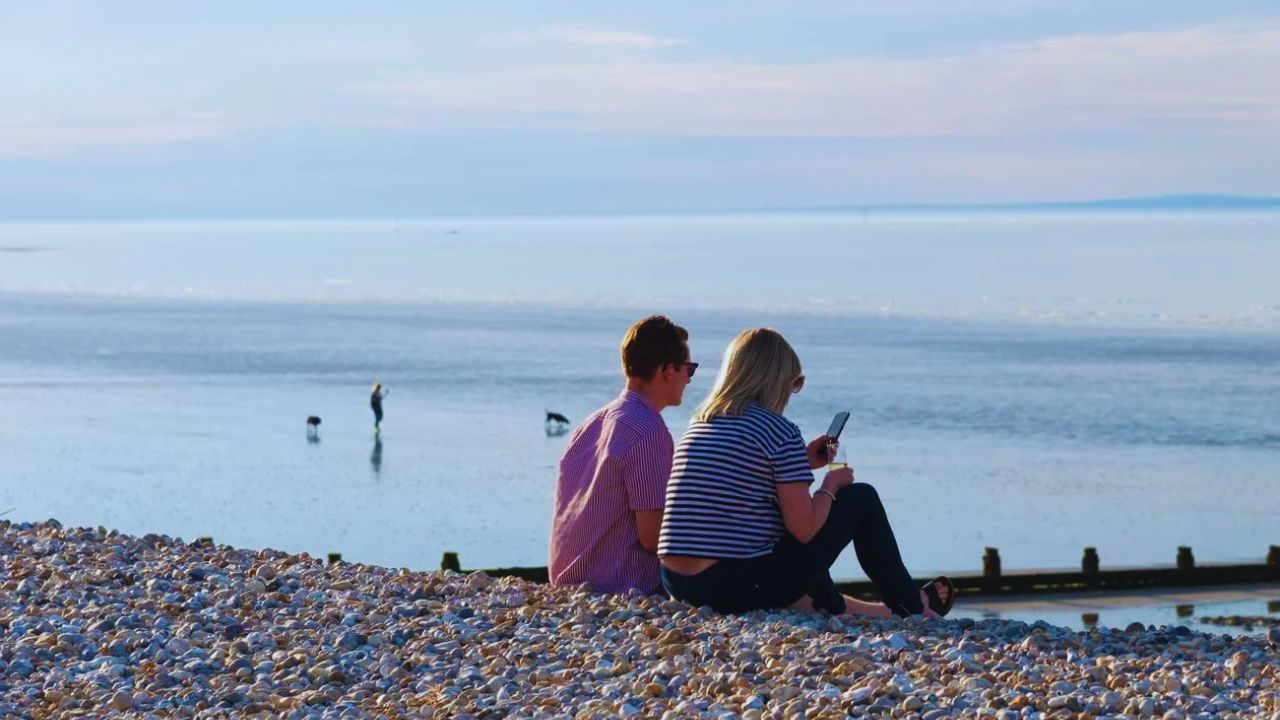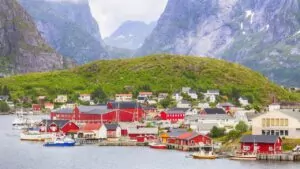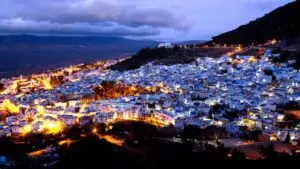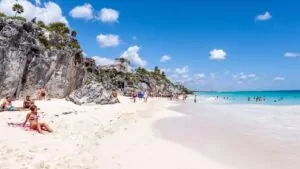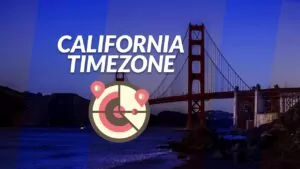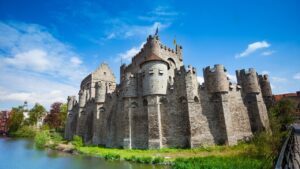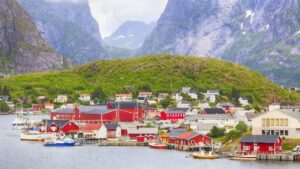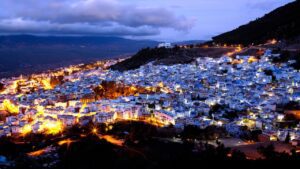The pull towards uncovering hidden gems that aren’t swamped with photo-snapping tourists can be strong, and boy, do I get it. The hunt for those special spots that offer a piece of magic without the crowds is a journey I’m all too familiar with.
On one such adventure, my path led me to Glass Pebble Beach in Fort Bragg, CA—a shoreline unlike any other adorned with vibrant sea glass rather than ordinary sand.
This shimmering beach wasn’t always a sparkling jewel. It’s quite the story: this place began as a dumping site by the Union Lumber Company, changing what was once debris into today’s breathtaking treasure trove.
Now nestled within MacKerricher State Park, it beckons not only for its stunning beauty but also as a striking testament to nature’s ability to repurpose our follies into something truly splendid.
In this blog post, you’ll find tips on when to visit for prime sea glass discoveries and how to make your trip both enjoyable and respectful of this delicate marvel. Prepare to be enchanted!
The Origin of Glass Pebble Beach
Glass Pebble Beach in Fort Bragg, California, began as a place where people threw their waste glass. Over years, the ocean turned that trash into colorful sea gems.
How Glass Beach Was Formed?
I visited Glass Beach in Fort Bragg, California, where I saw firsthand how nature turned a place of waste into wonder. After the 1906 earthquake, people threw broken bottles and debris into an area off the coast.
Over years, the ocean’s power transformed these discards into colorful sea glass. It takes about 20 to 30 years for sharp pieces of glass to smooth out into what I picked up that day: beautiful pebbles of sea glass.
Time and tide transform trash into treasures at Glass Beach
During my walks along the beach, I noticed not just sea glass but also remnants from its past life, like spark plugs and copper motor windings half-buried in sand. These finds tell stories from over a century ago, when this spot was less a sightseeing destination and more a dumping ground.
The transformation is remarkable; each piece of sea glass stands as proof of resilience against time and tide.
The Transformation from Trash to Treasure
Years ago, Glass Pebble Beach was not the picturesque spot it is today. This beach’s story began with its past role as a dumping site until 1967. The cleanup started before the area closed off for such uses.
Over time, nature worked wonders on the discarded debris, smoothing and shaping it into beautiful pieces of sea glass that now cover the beach sands. In October 2002, this place found a new purpose when incorporated into MacKerricher State Park, turning a once littered shore into a treasure trove for visitors.
My support goes to Captain Forrington from the Sea Glass Museum who suggests founding a research facility to study glass minerals found here. Even though there were talks about replenishing the glass by Fort Bragg City Council on December 10, 2012, these plans did not come to fruition.
Yet, this doesn’t take away from what Glass Pebble Beach has become – an emblem of transformation demonstrating how conservation and natural processes can revive and enrich our marine environment while creating an alluring tourist destination in Mendocino County.
What Makes Glass Pebble Beach Unique?
Glass Pebble Beach shines because of its colorful sea glass and the story behind it. Waves turned old trash into shiny treasures, making this spot a must-see.
Composition of Sea Glass
Walking along Glass Pebble Beach, I often marvel at how the sands shimmer with pieces of sea glass. This beach’s magic starts with its composition, a distinctive mixture that includes quartz, mafic rocks, feldspar, and, notably, rounded pieces of glass.
These bits of glass began as bottles and trash tossed into the ocean. Over about 30 years, the sea worked its wonders on them. Worn by waves and sand, sharp edges smoothed out until they became these colorful pebbles that now define the beach.
My walks here have taught me to appreciate not just the beauty but also the process behind each piece of sea glass I find. Every shade tells a story – from clear whites born from common beverage containers to rare blues hinting at old Vaseline jars or even rarer reds once part of nautical lighting.
Collecting sea glass here is like hunting for treasures crafted by both man and nature over decades. It’s an experience made richer knowing you’re walking on what was once considered mere refuse but has turned into something altogether more precious and sought after.
Varieties of Colors and Sizes
I’ve walked along Glass Pebble Beach many times, and each visit surprises me with the diversity of sea glass it offers. You’ll find pieces ranging from common colors like green, brown, and clear to more rare hues such as lavender, pink, red, and blue.
Among these treasures are the elusive fire glass pieces – a true rarity that sparkles under the sun.
The sizes of these pebbles vary just as much as their colors. From tiny fragments perfect for jewelry to larger chunks that make stunning decorative items, there’s something for every collector.
I remember finding a piece of red glass so large; it felt like holding a piece of history washed ashore.
Each piece of sea glass has its own story.
Exploring Glass Pebble Beach
Walking along Glass Pebble Beach, the ground sparkles under my feet. I spot sea glass in colors from green to blue, treasures waiting for those who look closely.
Best Spots for Sea Glass Collecting
I always make sure to visit Glass Pebble Beach during low tide. This is when the beach shows its hidden treasures, making it the perfect time for sea glass collecting. Here are my go-to spots on the beach and a few tips to find the best pieces:
- Northern Edge near Pudding Creek: The area around Pudding Creek acts like a natural collector for sea glass. After a storm, this spot can be especially rewarding.
- Below the Cliffs: At Glass Pebble Beach, the base of the cliffs holds larger pieces of smoothed-out glass from years of waves and sand. Look here for rare colors and shapes.
- Near Old Dump Sites: Parts of Glass Pebble Beach were once dump sites, now cleaned up but still home to rare finds. These areas often yield thick, frosty white and green glass.
- Tidepools at Low Tide: During low tide, small pools form along the shore, trapping smaller pieces of sea glass. This is where I search for tiny blues and reds, which are rarer.
- Along the Walking Path: Before even reaching the sand, keep an eye on the ground along the walking path down to the beach. Sometimes, you can find pieces washed up far from water.
- Hidden Coves between Rocks: Smaller coves sheltered by large rocks protect bits of glass from being taken back out to sea, making them great places to check out.
Always wear sturdy shoes, as I do; they’re essential for safety while searching around rocky areas and tide pools. Also, while movements to replenish Glass Pebble Beach with more sea glass have been suggested, remember that taking large amounts from these spots affects both beauty and local ecosystems. So collect sparingly or simply snap photos to preserve these colorful pebbles for everyone to enjoy.
Optimal Times for Visits to Maximize Finds
Finding the best sea glass at Glass Pebble Beach requires timing my visits carefully. I’ve learned that certain times are better for finding these treasures.
- Visit after high tide. The ocean leaves behind more glass as it goes back out.
- Full moon nights in spring or fall bring in rare finds. Sea glass is more visible under the moonlight.
- Early morning visits mean less competition from other tourists, making it easier to find rare pieces.
- spring and fall seasons see fewer visitors in general, so these times offer quieter beach days for thorough searching.
- I always check the local weather and tide charts before planning my trip; ideal conditions mean more fruitful searches.
- Joining local Facebook groups or forums dedicated to sea glass collecting gives me insider tips on the best spots and times.
- Planning my visit around low tourist times, outside of the summer months when 1,000 to 1,200 people visit daily, increases my chances of finding special pieces.
Using these strategies, I maximize my chances of uncovering beautiful sea glass pieces at Glass Pebble Beach, turning each visit into a special adventure along the picturesque California coastline.
Environmental Impact and Preservation Efforts
Glass Pebble Beach shows us how nature can turn old things into beautiful treasures. Conservationists work hard to protect this beach and the creatures that call it home.
Role in Local Ecosystem
Glass Pebble Beach plays a critical role in the local ecosystem, much more than one might realize at first glance. Home to endangered plants like Menzies’ wallflower and various wildlife species, including striped shore crabs, this beach contributes greatly to biodiversity.
I’ve witnessed how these native species rely on the special habitat that Glass Pebble Beach offers. It serves as a reminder of nature’s resilience.
The conservation measures in place aim to protect these vital parts of the ecosystem. During my visits, I’ve seen signs urging visitors not to remove sea glass because it’s part of what makes this habitat so special for wildlife and flora alike.
Striped shore crabs often hide among the colorful pebbles, blending seamlessly into their surroundings, while Menzies’ wallflower thrives amidst the unusual environment that has sprung from decades of past actions.
“Protecting our natural habitats preserves our future.”
Conservation Measures in Place
I’ve seen firsthand the efforts to keep Glass Pebble Beach beautiful and sustainable. State Park Rangers play a huge role in this by discouraging visitors from taking sea glass. This policy helps preserve the beach’s rare charm for future generations to enjoy.
It struck me as a bold move, especially since collecting these colorful treasures can be tempting.
The city also had its say on conservation efforts. Back in December 2012, there were talks about replenishing the sea glass to maintain the beach’s allure. Still, Fort Bragg City Council decided against it, choosing instead to let nature take its course.
This decision marked a major step towards natural preservation over human intervention, highlighting a commitment to ecological balance within MacKerricher State Park, where Glass Pebble Beach has been since October 2002.
Such measures ensure that tourist attractions like trails and shores around Noyo River remain pristine, blending tourism with environmental care seamlessly.
Activities and Attractions at Glass Pebble Beach
Glass Pebble Beach offers more than just beautiful sea glass. Visitors can capture stunning photos and visit nearby places like the Skunk Train and Guest House Museum.
Photographic Opportunities
I find Glass Pebble Beach to be a photographer’s paradise, especially during the golden hours of sunrise and sunset. The way light reflects off each piece of sea glass creates a kaleidoscope of colors that are simply breathtaking.
Capturing this beauty isn’t just about having a good camera; it’s about finding the right angle to show how nature has turned what was once trash into treasured jewels. I often walk along the beach, looking for seals or the vibrant blooms that add life to my shots.
Every photo tells a story of change and beauty
Nearby, experiences like riding the Skunk Train or exploring trails on horseback offer more than just seaside views. These adventures provide special backdrops for photos that capture the essence of Northern California’s coast.
Whether it’s snapping pictures while pedaling through redwood forests or framing a seafood dinner from one of our local restaurants, every moment here makes for an unforgettable photo opportunity.
Nearby Attractions and Amenities
After spending time at Glass Pebble Beach, I love to explore more nearby. The Redwoods Railbike adventure is a must-do. It lets you pedal along railroad tracks through the ancient redwoods.
Feeling adventurous? The Skunk Train takes you on a historic ride through the forest. For animal lovers like me, the Sonoma Horseback-Riding Tour is perfect for seeing the landscape in a new way.
I also enjoy local scavenger hunts that lead me to hidden gems in Fort Bragg and beyond. They’re great for all ages and help me find places I wouldn’t discover on my own. And of course, dining out is part of the experience too.
There are restaurants with views of the sea where seals often play while I eat. Walking seaside trails filled with blooming flowers tops off my day perfectly.
Visitor Tips for Glass Pebble Beach
Check out the best times to go and what to bring for a great visit to Glass Pebble Beach. Follow the rules for taking sea glass and stay safe while having fun.
Safety Precautions
Exploring Glass Pebble Beach in Fort Bragg, CA, presents a remarkable adventure. I learned quickly that wearing sturdy shoes and carefully traversing the area’s steep hills and makeshift trails requires caution.
- Always wear sturdy, closed-toe shoes to protect your feet from sharp pieces of glass and uneven surfaces. I found this out the hard way when my flip-flop broke, leaving me to carefully pick my way back over pebbly terrain.
- Bring a small first-aid kit for minor cuts or scrapes. Despite being careful, I nicked my finger on a particularly sharp shard of sea-glass, and having band-aids handy was a lifesaver.
- Stay on marked trails to preserve the beach’s natural beauty and protect yourself from getting lost or injured. The dirt paths can be misleading, but sticking to known routes made my journey safer.
- Check tide charts before visiting; high tide can restrict beach access and make certain areas dangerous. I planned my trip during low tide, which gave me ample space and safety to explore.
- Keep an eye on the weather forecast; fog can reduce visibility dramatically along this part of the coast, making it easy to lose your footing or misjudge distances.
- Respect local wildlife by maintaining a safe distance—ssea stars and other creatures call this beach home, too.
- Heed all posted signs regarding areas off-limits for climbing or exploring; these are in place for safety reasons. One sign pointed out a risky cliff edge that wasn’t as stable as it looked.
- Refrain from taking sea glass from the beach; preserving its distinct beauty means leaving it for others to enjoy too.
- Photograph carefully; setting up for the perfect shot shouldn’t compromise your safety or that of others around you.
Following these guidelines ensured that my visit was not only enjoyable but also safe. It allowed me to experience the enchanting beauty of Glass Pebble Beach without harming myself or the environment.
Rules on Sea Glass Collection
I learned quickly that taking glass from Glass Pebble Beach isn’t allowed. State Park Rangers make it clear: our love for these vibrant pieces can lead to their disappearance. Each visit, I witness the beach’s beauty, but also understand why we must leave it untouched.
It’s about preserving this spot for everyone to enjoy, not just us today but future visitors too.
On my walks along the shore, I see colors and shapes special in each piece of sea glass. These treasures tell a story of change from trash to treasure, yet they must remain part of this coastal tapestry.
Following the rules means we all play a part in keeping Glass Pebble Beach magical and full of wonder for generations to come.
What to Look for at Glass Beach
At Glass Pebble Beach in Fort Bragg, CA, you’ll see an amazing sight of sea glass shining under the sun. This beach stands out because it turns what was once waste into a beautiful landscape.
Look for sea glass in common colors like green, brown, and clear. But keep your eyes peeled for rare pieces too! Lavender, pink, red, and blue shades are treasures among the pebbles.
The rarest find? Fire glass
You might also spot some history among the glass. Old spark plugs and bits of copper motor windings tell stories from past decades. These objects remind us how long this change from trash to treasure has taken.
Don’t forget to bring a bag for collecting while exploring this special place on California’s coast. Finding a piece of history that the ocean itself has polished is what this place is about, not just beaches or surfers.
Best Times to Visit for Sea Glass Collecting
I find the best time to collect sea glass at Glass Pebble Beach is right after high tide or during a full moon. These times are perfect because the ocean just left fresh treasures on the shore for us to find.
Spring and fall are also great seasons because the beach is not too crowded, and you can take your time looking for that special piece of sea glass.
Visiting during low tide gives me more beach to search. This is when I often spot larger pieces of sea glass, hidden among pebbles and sand. The sunlight in these hours makes the colors pop, helping me see the blues, greens, and even rare shades like vaseline glass better.
It feels like a treasure hunt each time I go, especially near Willits, where fewer people think to look.
Photography Tips at Pudding Creek Beach
Capturing the perfect shot at Pudding Creek Beach requires a keen eye and some planning. I make sure to wear sturdy shoes for stability as I traverse the rocky terrain, looking for the best angles.
The beach offers an exceptional backdrop with its dramatic coastline and vibrant sea life, including seals that sometimes bask in the sun. Early mornings or late afternoons are golden hours for photographers due to the soft, natural light enhancing colors.
This magical lighting brings out the textures of sand, rock, and water beautifully.
As someone who has explored many glass beaches, from Sanibel Island to the Abaco Islands, finding distinct perspectives is essential. At Pudding Creek Beach, I focus my lens on contrasting aspects — where sparkling sea glass meets rugged natural scenery.
Close-up shots of individual pieces of sea glass can tell a story of transformation from trash to treasure. For wider landscape images, I use a lower aperture setting on my camera to keep both foreground details and distant vistas sharp.
Remembering visits during blooming seasons adds bursts of color, with seaside flowers framing shots naturally without any fluff content necessary. Important too; high tide can bring significant changes to the landscape but may limit access to certain areas.
Takeaways
Glass Pebble Beach truly stands out as a gem in Fort Bragg, CA. Its vibrant sea glass and fascinating history catch the eye of many visitors. To get deeper insight, I spoke with Dr.
Marina Silva, a marine biologist with over 20 years of experience focusing on coastal ecosystems. Dr. Silva holds a Ph.D. from the Coastal University of Science and has conducted groundbreaking research on how beaches like Glass Pebble transform over time.
Dr. Silva explained that Glass Beach’s beauty is not just for show; it serves an ecological purpose too. The colorful pebbles provide habitats for tiny creatures and help to control beach erosion—a natural protective mechanism for our shores.
She stressed the importance of respecting this delicate ecosystem by following local guidelines when visiting—like not removing the glass from its home—and highlighted efforts to preserve this area, keeping its wonders for generations.
In everyday life or during visits, Dr. Silva suggests taking walks along these shores to observe wildlife activity among the glass pebbles or even engage in responsible photography that captures their rare glow without harming their environment.
While discussing pros and cons, she acknowledged that while Glass Beach offers incredible vistas and educational value, overcrowding could pose threats to its sustainability—it’s smaller than many think! She advises comparing your visit here with less crowded nature spots if peace is what you’re after.
For her final verdict? Dr. Marina Silva wholeheartedly recommends exploring Glass Peach Beach but urges visitors to do so responsibly—to enjoy its unmatched charm while preserving its natural state for everyone’s future enjoyment.

